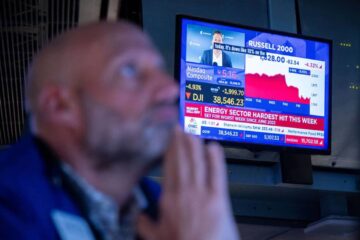Stocks are slipping modestly lower heading into what could be a crucial speech from Fed Chair Jerome Powell later in the session.
U.S. equity futures slipped lower Wednesday, while the dollar extended declines against its global peers, as investors looked to a headline address from Federal Reserve Chairman Jerome Powell later in the session while bracing for a series of key economic data releases.
With stocks holding onto a solid November gain of around 2.15%, and set to enter what is traditionally the strongest month of the year in terms of annual performance, investors are hoping that Powell doesn’t strike too hawkish a tone ahead of PCE inflation data tomorrow and the Fed’s next policy meeting in mid-December.
At present, markets are pricing in a 70% chance of a 50 basis point rate hike next month, with the bulk of expectations pointing to a peak Fed Funds rate of between 5% and 5.25% by early spring before the central bank starts to pause its rate hiking cycle.
That could be challenged, however, by a resilient domestic economy, with the second estimate of third quarter GDP published Wednesday showing a better-than-expected reading of 2.9%, thanks in part to consumer and business spending that offset slower inventories.
Stocks Nudge Higher, Powell, Bankman-Fried, Biogen, HPE in Focus -Five Things To Know
Heading int the start of the trading day on Wall Street, futures tied to the S&P 500 are priced for a modest 4 point opening bell dip while those linked to the Dow Jones Industrial Average are indicating a 35 point decline. The tech-heavy Nasdaq is priced for a 5 point dip.
Powell is slated to speak at 1:30 pm Eastern time at the Hutchins Center on Fiscal and Monetary Policy at the Brookings Institution on the outlook for the economy, inflation, and the changing labor market, with a question-and-answer session from the audience to follow.
His remarks must also be squared against the sharpest inversion of the U.S. Treasury yield curve since the early 1980s, with the gap between 2-year and 10-year notes holding at around 75 basis points.
Beyond that, the yield of 1-month Treasury bills is now sitting at 4.014%, some 23 basis points over 30-year bonds, a level of inversion that has preceded each of the last three recession.
However, the Atlanta Fed’s GDPNow forecasting tool suggesting the U.S. economy is growing at a 4.3% clip in the fourth quarter, up from its 4.2% estimate earlier this month.
Jobs data will also play a key role in that assessment, with ADP’s November employment report showing a smaller-than-expected gain of 127,000 new private sector hires. The October reading of JOLTs job opening at 10:00 am is, however, expected to show that there are still some 10.3 million unfilled positions in the world’s biggest economy, a level many analysts say will still feed into wag increases and inflation pressures.
The U.S. dollar index, which tracks the greenback against a basket of six global currencies, was marked 0.32% lower in overnight trading at 106.481, suggesting again the currency traders are betting that inflation may have peaked in recent months, while benchmark 10-year Treasury note yields bumped to 3.779% in early New York trading.
Weaker-than-expected factory activity data from China, where PMI data showed a deep November contraction — to the lowest levels in 7 months — linked to Covid lockdowns and manufacturing closures, added to bets that Beijing will need to alter its strict stance in the months and weeks ahead.
China stocks booked modest gains on the session, while the region-wide MSCI ex-Japan benchmark rose 1.58% heading into the close of trading. In Europe, the region-wide Stoxx 600 was marked 0.62% following a slower-than-expected November inflation reading of 10%, while Britain’s FTSE 100 added 0.43% in London.


